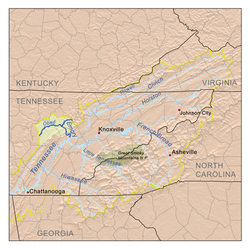Emory River
| Emory River | |
|---|---|
 The Emory River near Oakdale, Tennessee | |
| Origin | Morgan County, Tennessee |
| Mouth | Clinch River |
| Basin countries | USA |
| Mouth elevation | 741 ft (226 m) [1] |

The Emory River is a stream draining a portion of Tennessee's Cumberland Plateau.
Hydrography
The Emory River rises on the slopes of Frozen Head and Bird Mountain, prominent peaks in that part of the Cumberland Plateau in Morgan County, Tennessee. Frozen Head is the focus of a Tennessee state park and natural area called Frozen Head State Park. The surrounding area has been the subject of extensive strip mining for coal which has resulted in some stream pollution. The stream initially flows basically westward and is crossed by U.S. Highway 27. Turning more southwestward, it is paralleled for a time by a line of the Norfolk Southern Railway. It meets the Obed River in the southeast corner of the expansive Catoosa Wildlife Management Area, a large game-management area operated by the Tennessee Wildlife Resources Agency.
In an unusual departure from the generally accepted convention that the larger stream name is retained downstream of the confluence with a notably smaller one, the stream from this point retains the name "Emory River" even though the Obed at the point of confluence is considerably larger than the Emory. Still paralleled by the railroad, the stream crosses into Roane County near Harriman. Backwaters of the Watts Bar Lake impoundment of the Tennessee River cause the water below Harriman to be somewhat slack. The Little Emory River is also impounded somewhat above its mouth into the Emory below Harriman.
The mouth of the Emory is into the Clinch River at the Tennessee Valley Authority's Kingston Power Plant, a coal-fired electric generation station initially developed during World War II, largely to power the uranium enrichment plants used to make the world's first atomic bomb at nearby Oak Ridge National Laboratory. The 2008 Kingston Fossil Plant coal fly ash slurry spill heavily polluted the Emory river and surrounding area.
Etymology
According to a 1910 article in the Rockwood Times by Captain William E. McElwee,[2] the river was named after "William Emery", an early traveler who drowned while swimming the river with his "accoutrements" on. Early deed books sometimes refer to this as "William Emeries River".[3] The Indian name for the Emory River was "Babahatchie", which means "babbling waters." [4]
See also
- List of Tennessee rivers
Notes and references
- ↑ U.S. Geological Survey Geographic Names Information System: Emory River
- ↑ On the Roane County Heritage Commission website (accessed December 1, 2009), Robert L. Bailey advises that the stories in the historical articles that McElhee published in the Rockwood Times between 1902 and 1919 "must be taken with 'a grain of salt.'"
- ↑ Tennessee, Roane County Deed Book D, pages 7 & 8
- ↑ Roberts, Snyder E. (1981) Roots of Roane County, Tennessee - 1792 -